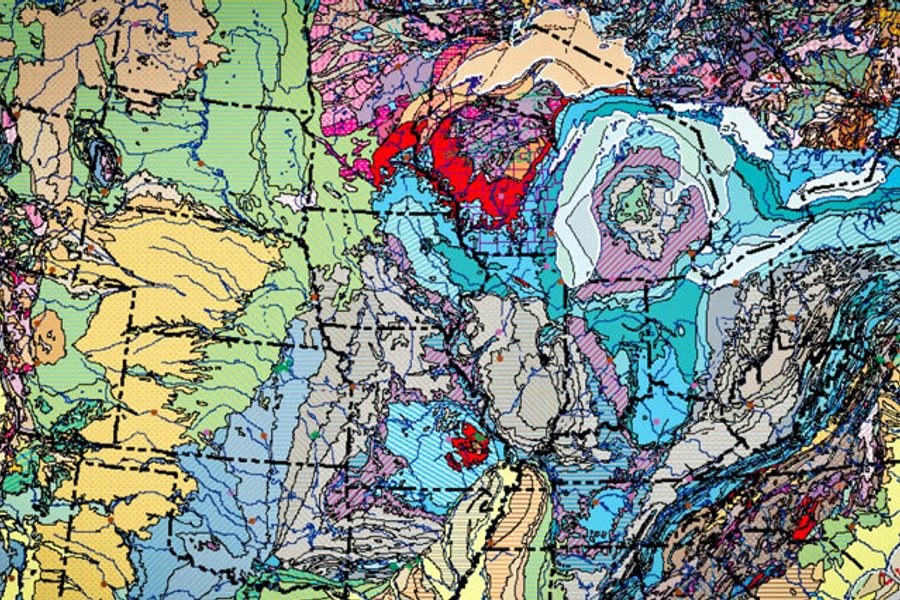Frack You and the Sand You Rode In On
Fracking’s evil twin: the mining of prehistoric sand.
Terry J. Allen

Safely buried Since the Pleistocene age, danger is stirring. Driven by unbridled lust for energy and wealth, small men with giant tools are unleashing a lethal demon on villages and farms across America’s upper Midwest.
OK, now that I have your attention, here’s the less sensational, but still chilling version of how the mining of prehistoric sands — used in the hydraulic fracking of oil and gas — threatens the health of humans and the environment.
The downsides of extracting hydrocarbons by high-powered fracturing of petroleum-rich shale rock are well known. But fracking could not function without a lesser-known tandem industry: mining crystalline silica sand, large deposits of which lie just below the surface in areas of Wisconsin and Minnesota.
Increasingly, vast, open-pit frac-sand mines blight the landscape like earth’s own acne.
During the fracking process, tough, spherical grains of frac sand are “suspended in fluid and injected into oil and gas wells under very high pressure,” explains the website of Wisconsin-based Glacier Sands LLC. “The fluid pressure opens and enlarges fractures as well as creates new ones,” and the injected sand props open the fractures after the fluid is pumped out. The “proppants” may also create an escape route for toxic chemicals such as methane, benzene, toluene and radon.
While concerned citizens see risk, the industry touts job creation and cheap energy. “It’s all an upside,” Glacier Sands Vice President Brian Iverson told WinonnaDailyNews.com about a proposed facility, 1,000 feet from a school. “We don’t see a downside.”
Others do. Environmentalists warn that frac-sand mining can: generate airborne particles that cause cancer, silicosis and other lung diseases; undermine conservation and exacerbate climate change by perpetuating reliance on cheap fossil fuels; scar the landscape; destroy property values; create 24/7 truck traffic, noise and infrastructural damage to tax-payer-funded roads and bridges; undermine aquifer quality and renewability; fill streams with silt; create ponds fouled with industrial waste; contaminate groundwater with processing chemicals; and ruin fertile farmland.
Commerical fracking goes back to 1949, when Halliburton, of Dick Cheney fame, became the first company to try it. The technology came into its own in 2005 after Congress passed the “Halliburton loophole,” exempting fracking from most major federal environmental regulation. By 2008, a push to increase domestic energy sourcing and higher fossil fuel prices had helped spur a fracking boom. In the decade leading up to 2012, shale gas production expanded 2,400 percent nationally, according to the U.S. Energy Information Administration.
The U.S. fracking industry bought $3.7 billion worth of sand in 2011, according to The Freedonia Group, a business research firm. Every week, just one 400-acre mine and processing facility in Trempealeau County, Wis., “ships 7,500 tons of sand by rail to oil and gas fields in Texas, North Dakota and Pennsylvania,” wrote the Wisconsin Center for Investigative Journalism’s Kate Prengaman in July 2012.
“Bleak sandy wastelands punctuated with waste ponds and industrial installations [lie] where Wisconsin hills once stood,” Ellen Cantarow reported in her excellent TomDispatch.com article about frac-sand mining.
Frac-sand mining’s most imminent threat to human health is silica dust, which Wisconsin labels a “carcinogenic hazardous air pollutant” and a cause of silicosis—the incurable, progressive disease that was endemic in miners and stoneworkers until it was slowly curbed by federal workplace-safety regulations. There are no such federal standards for silica in ambient air. The fine particles that can cloud the air during digging, processing, storing and transport cause the “most concern,” the Minnesota Pollution Control Agency warns. And although concentrations of silica from sources including frac sands “could be above a level of concern,” according to a 2011 Wisconsin Department of Natural Resources (DNR) report, the state has neither the ability nor the authority to regulate them. Nor, said the DNR report, can it even “determine conclusively whether … silica emissions in the state may be a public health concern.”
Until then, perhaps the public could just cut down on breathing.









